Abstract
1. Effects of synthetic atrial natriuretic peptide (ANP) on renal excretion, total renal blood flow (RBF), glomerular filtration rate (GFR) and tissue electrical admittance (reciprocal impedance, an estimate of tissue electrolytes) were determined in pentobarbitone-anaesthetized rats. GFR was measured both as inulin clearance (Cin) and as a product of renal plasma flow (RPF) and inulin extraction ratio (Ein). 2. With the lowest dose of ANP (0.35 micrograms/(kg min) I.V.) a 5-fold increase in sodium excretion occurred without measurable change in Cin, RPF x Ein nor medullary electrolyte concentration estimated from tissue electrical admittance. 3. With medium and high dosage (2 and 6 micrograms/(kg min), respectively), major and rapid increases in sodium excretion and urine flow were associated with an acute increase in Cin but not RPF x Ein. 4. The RBF increase observed in all groups of rats was not dose-related and did not parallel the natriuresis. Electrolyte concentration in the medullary tissue showed a modest transient decrease in rats given medium and high ANP doses. 5. We conclude that pronounced ANP natriuresis can develop in the absence of a measurable increase of GFR, estimated by a method not subject to urinary dead space error (RPF x Ein). The small transient decrease in medullary tissue electrolytes observed with higher peptide doses does not support solute wash-out as an important mechanism of increased sodium excretion.
Full text
PDF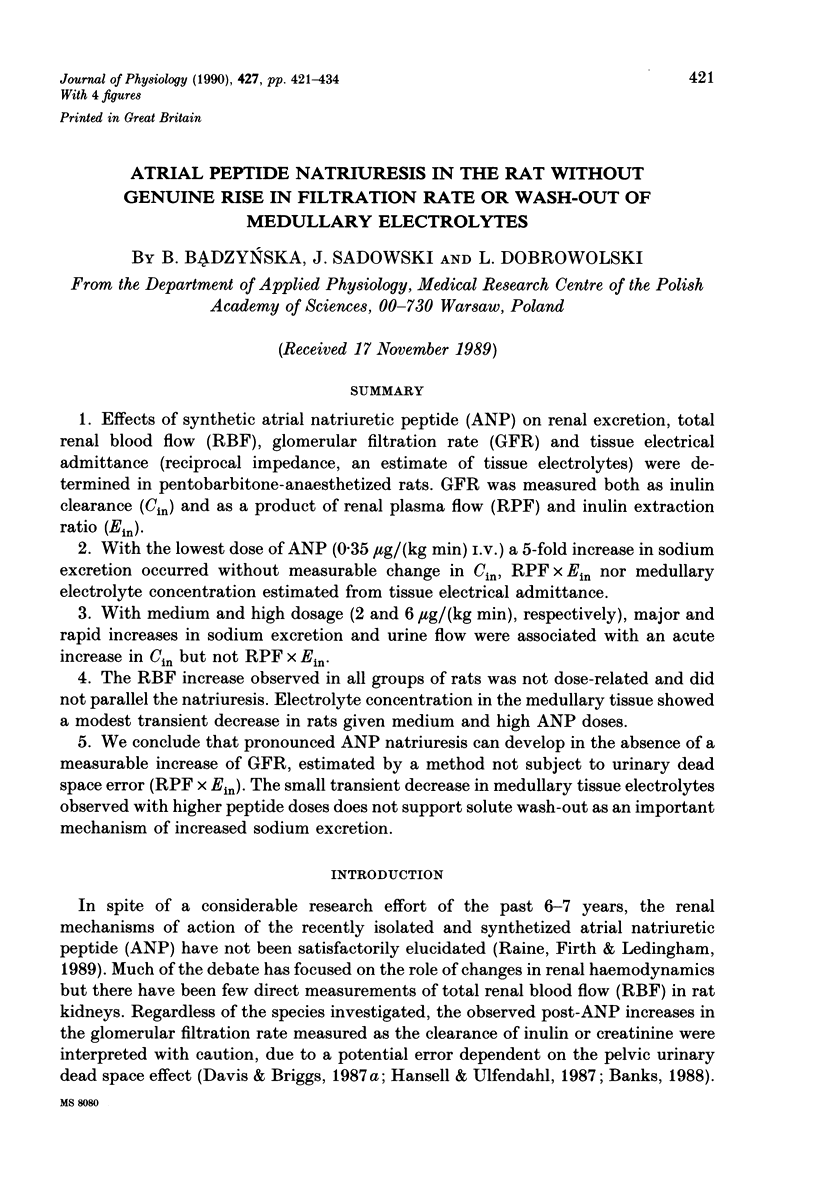
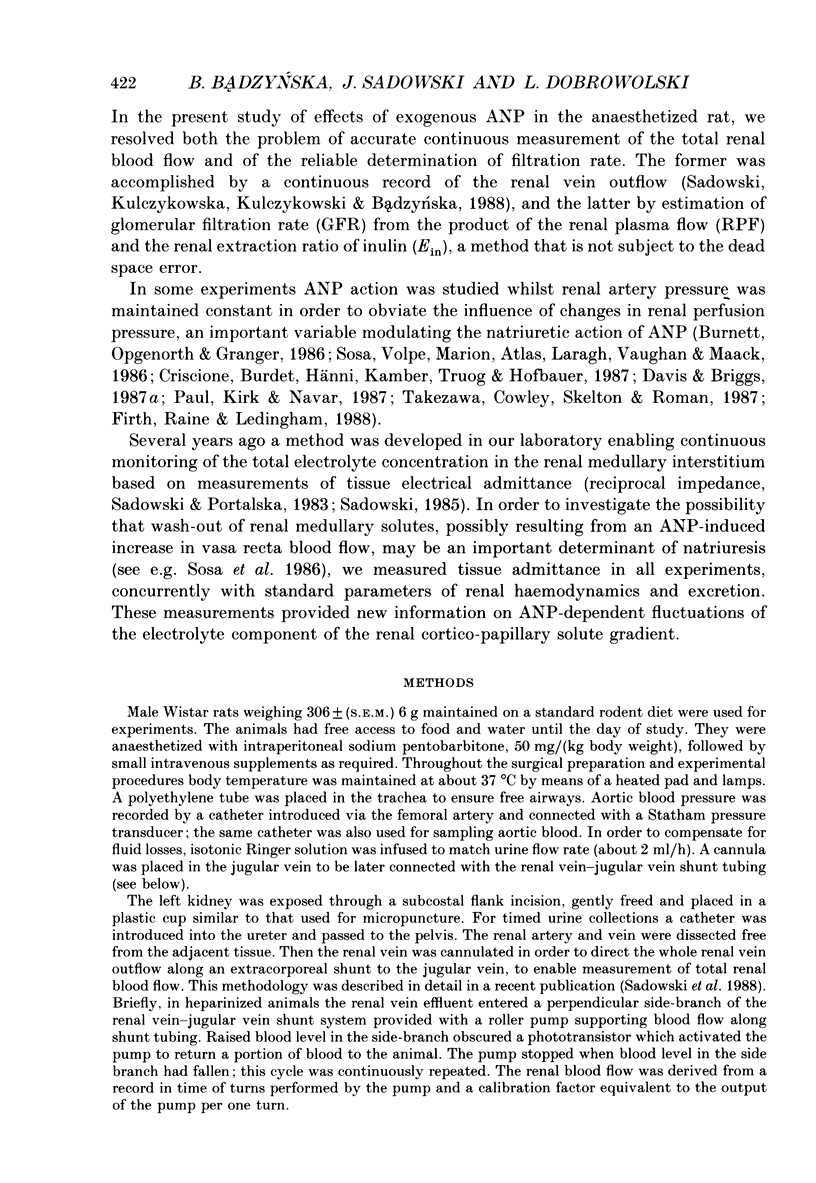
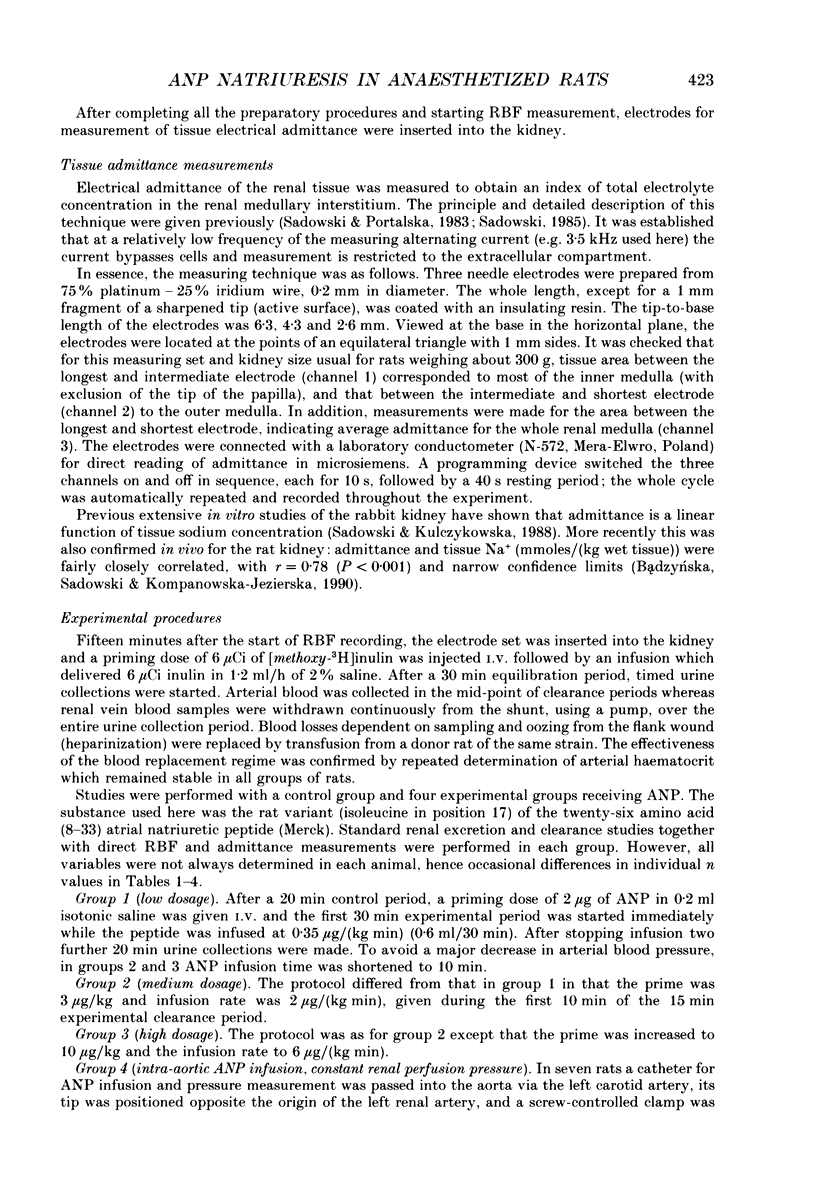

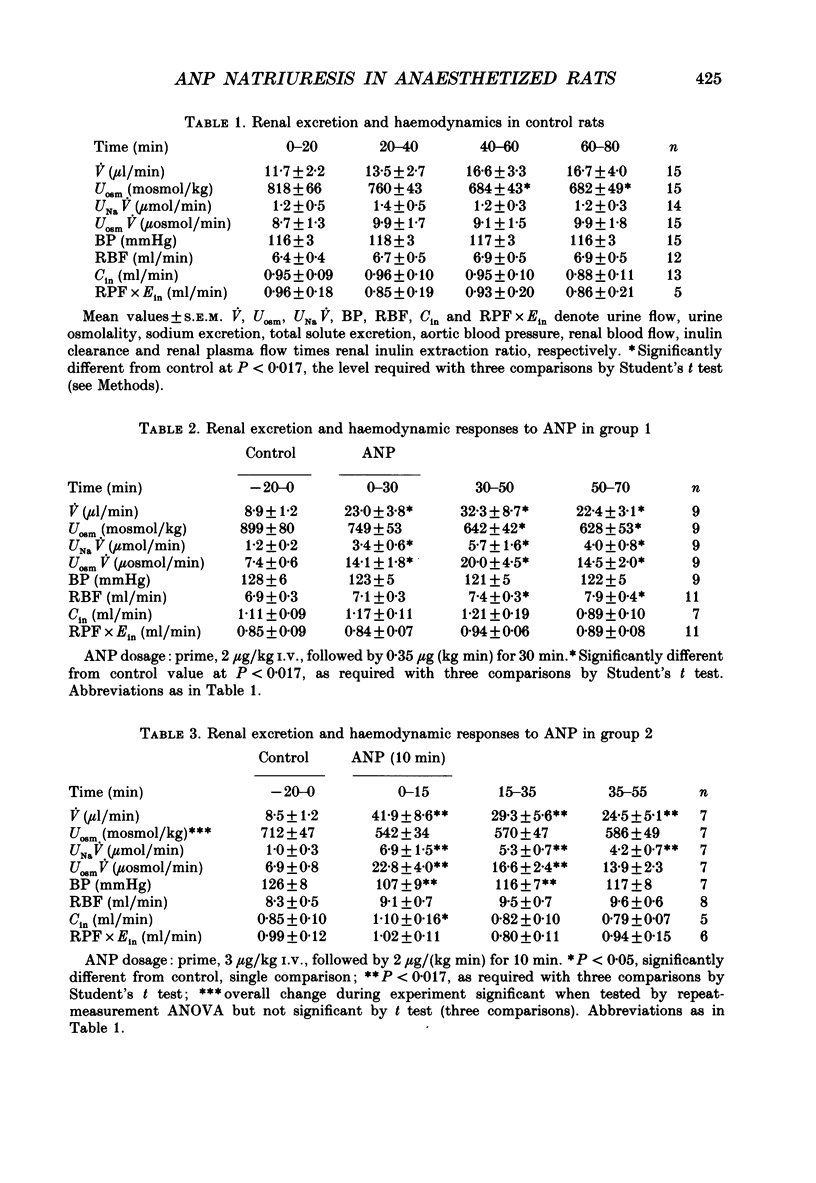
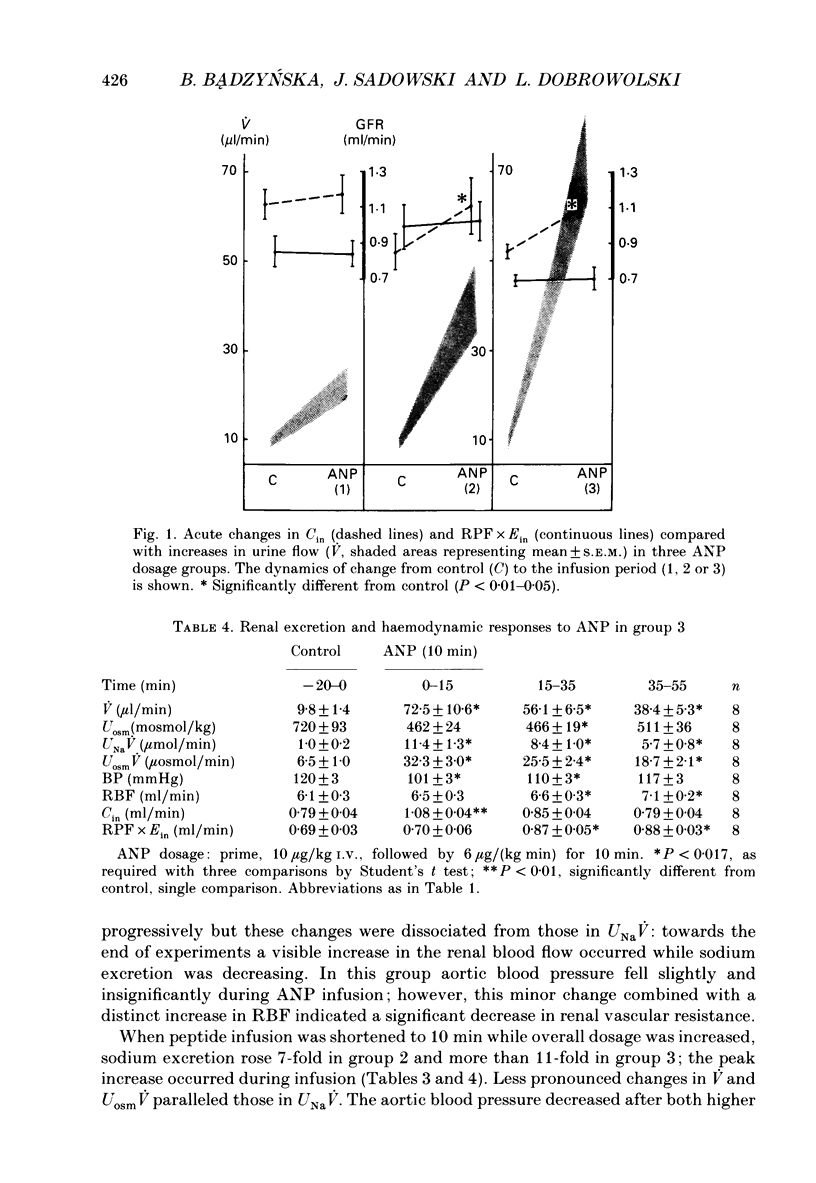
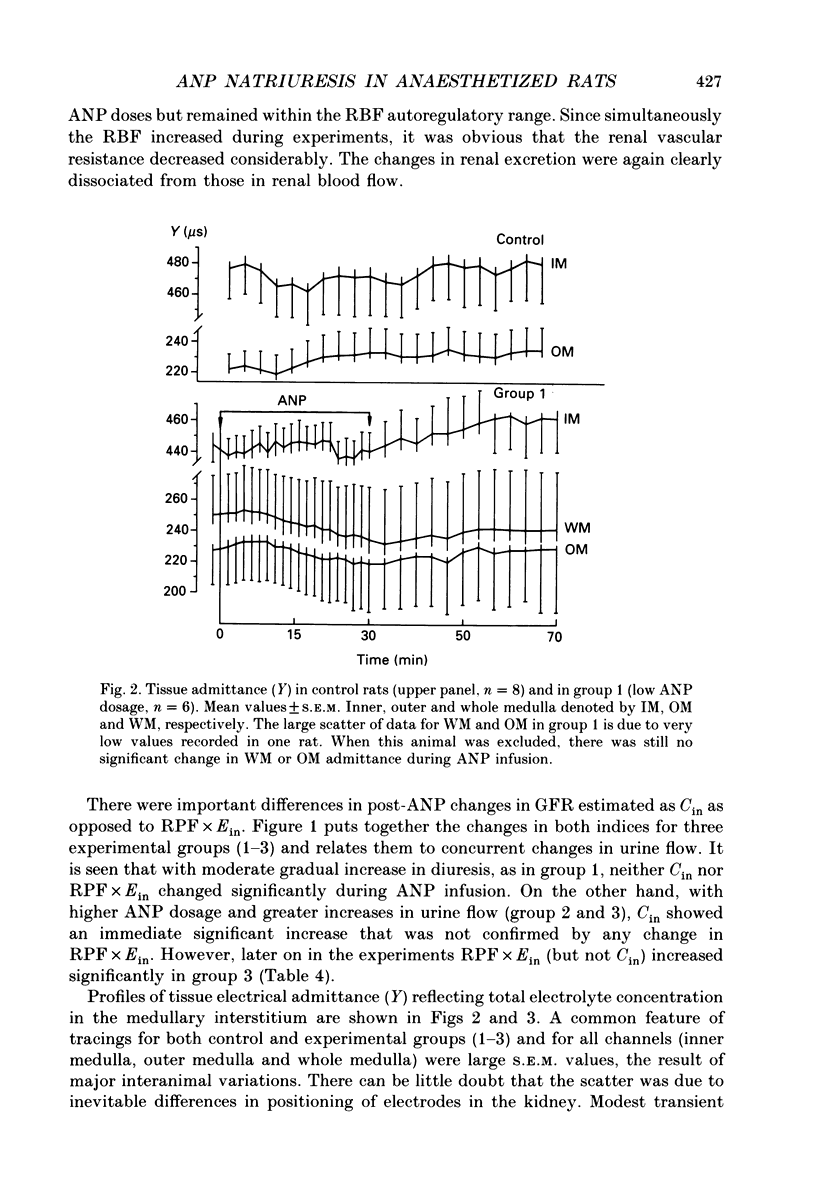
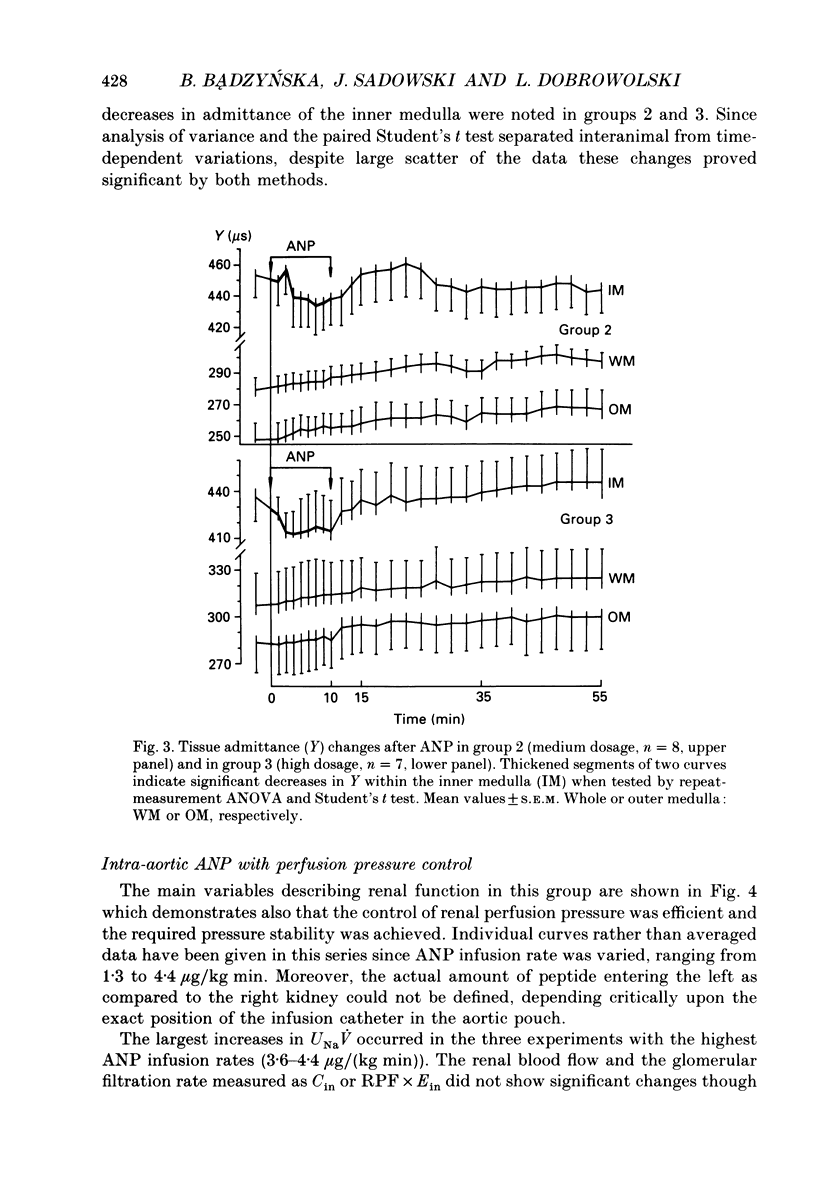
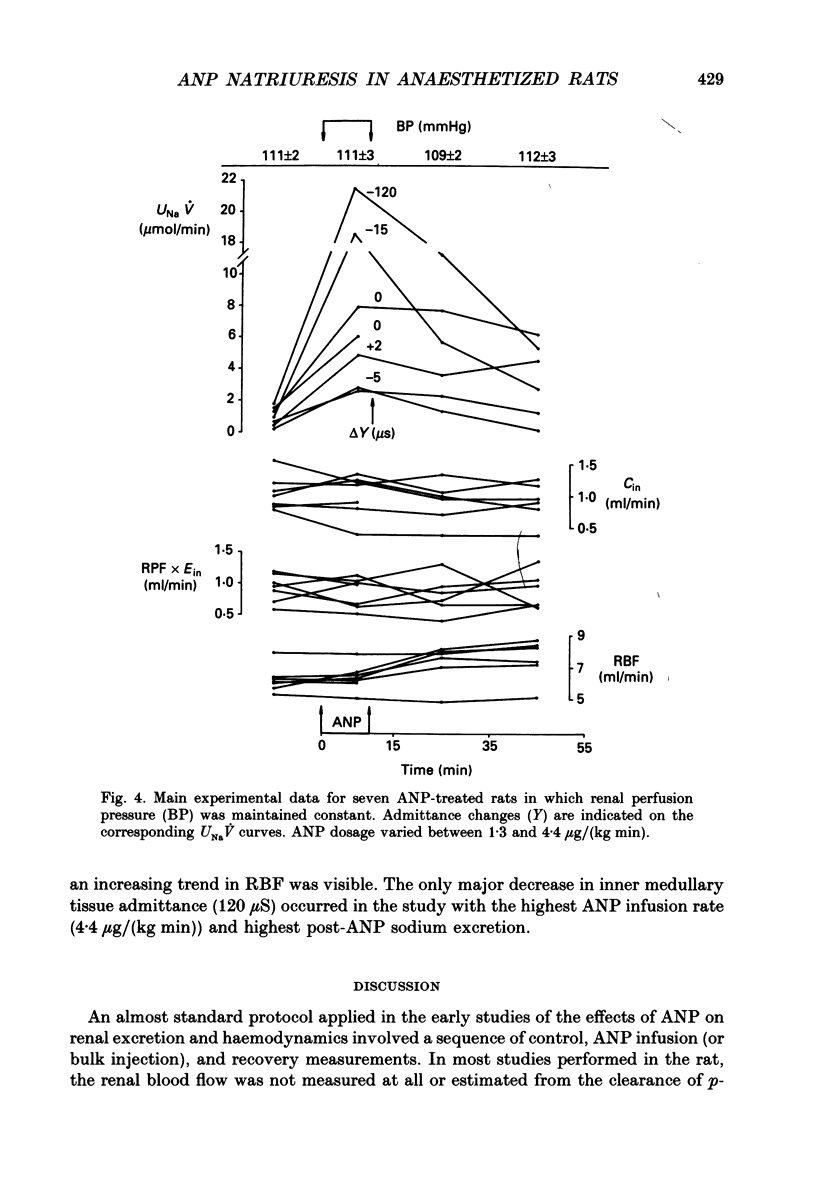
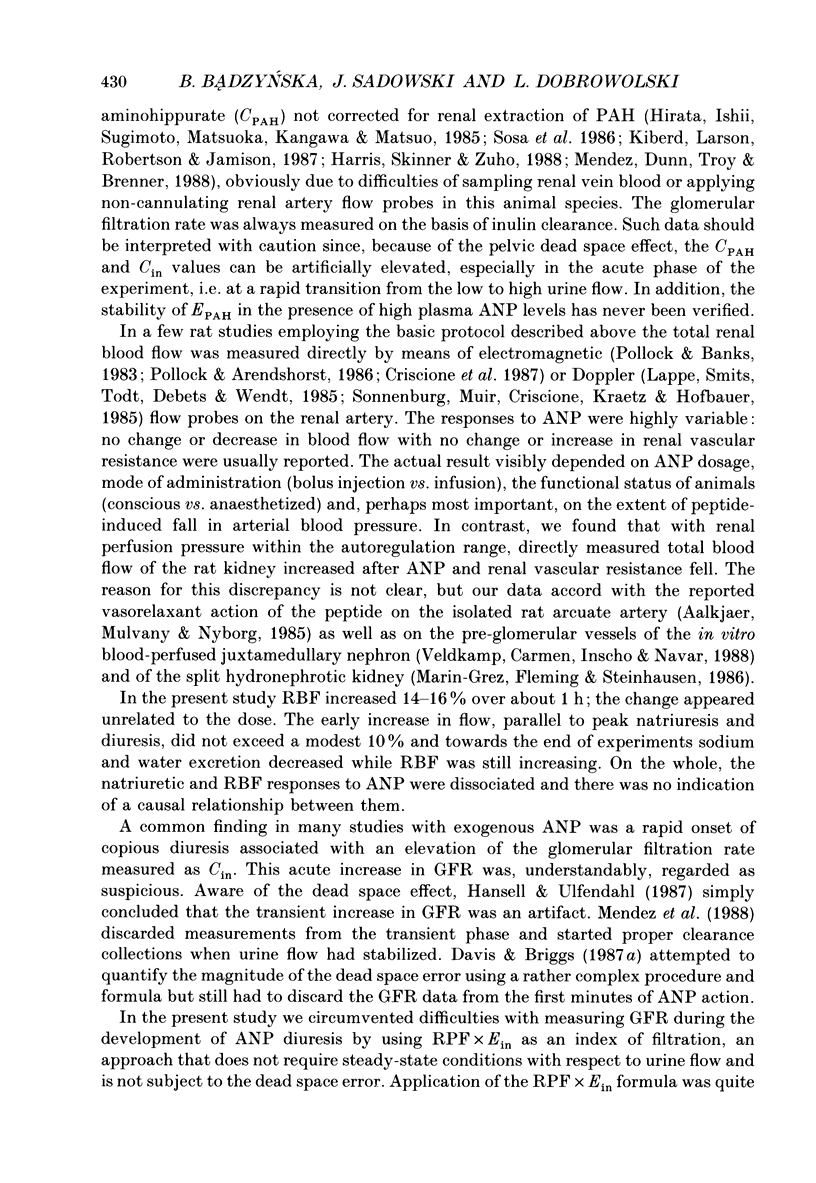
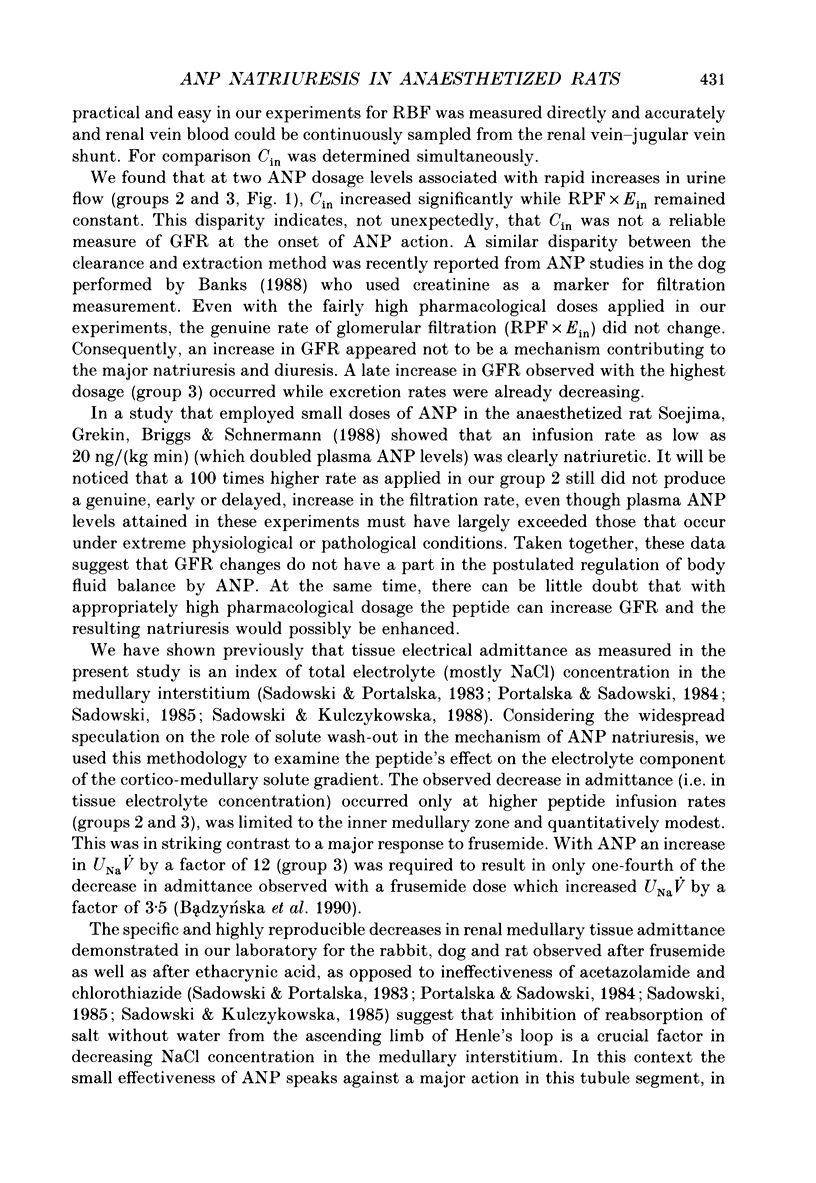
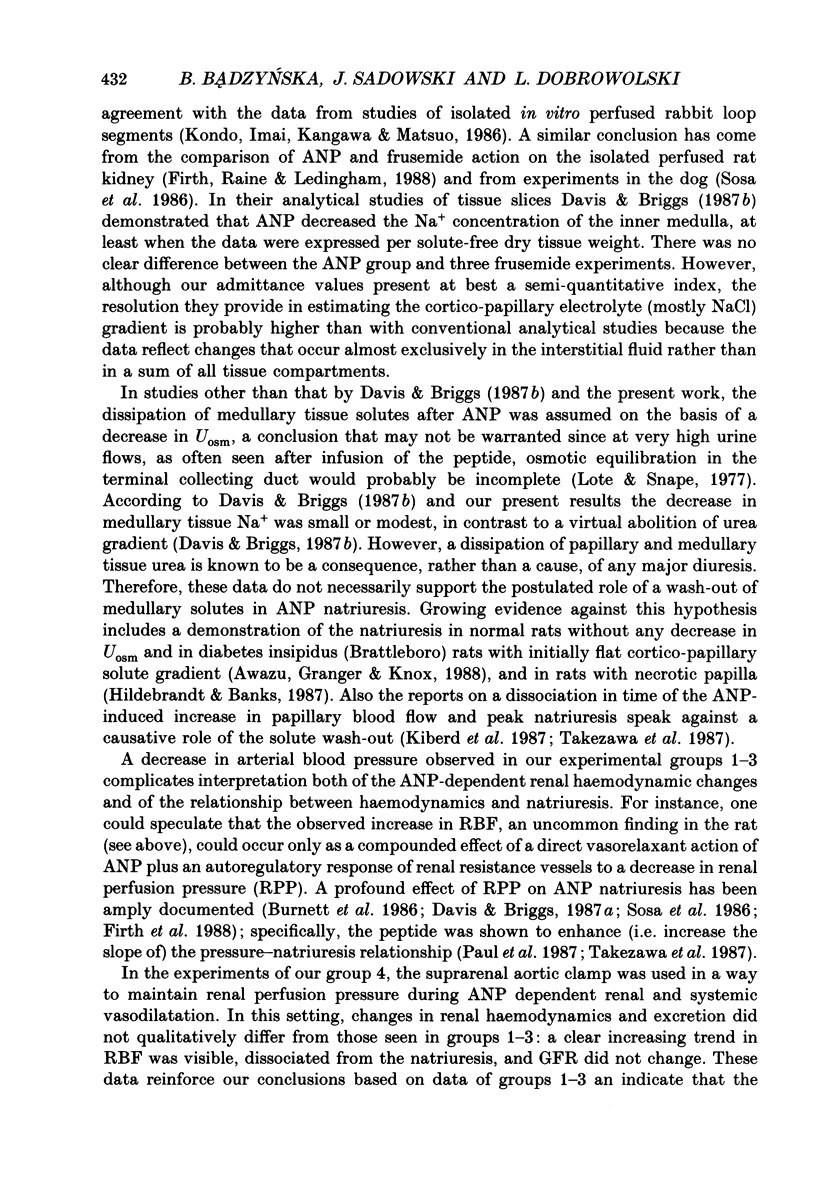
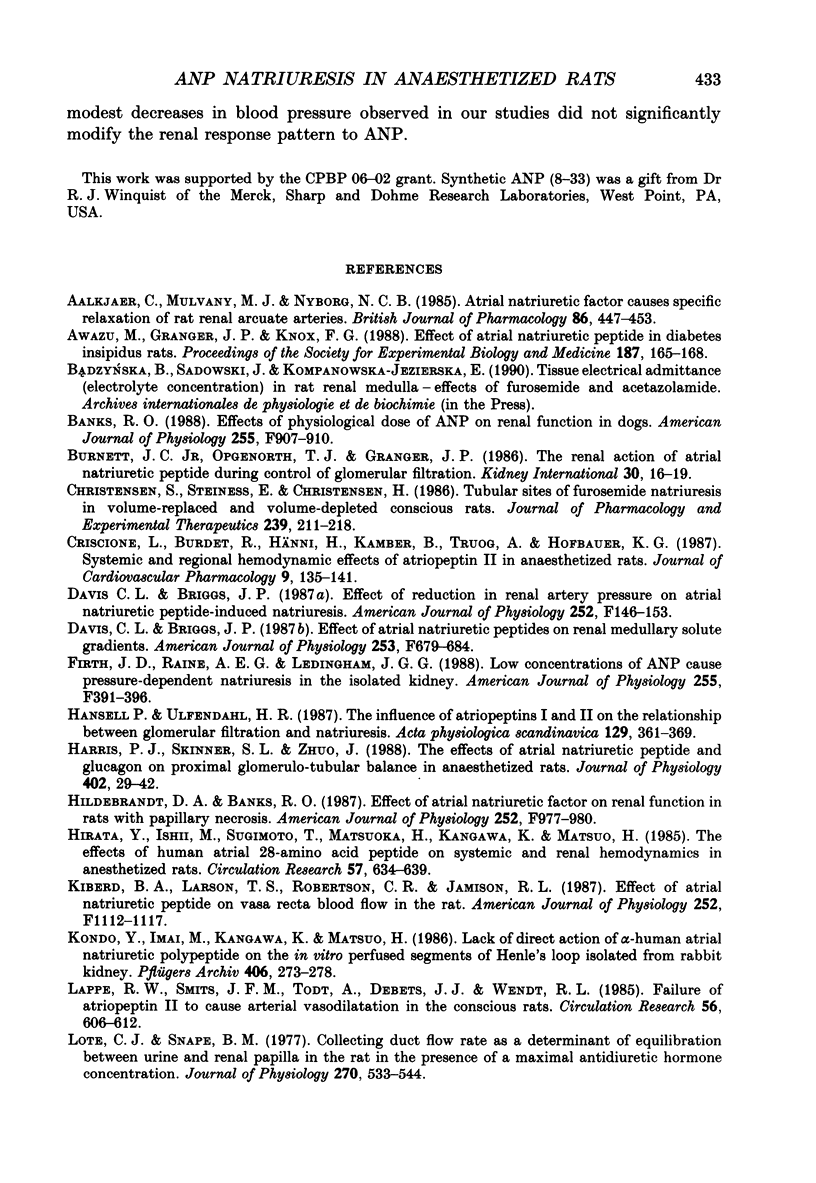
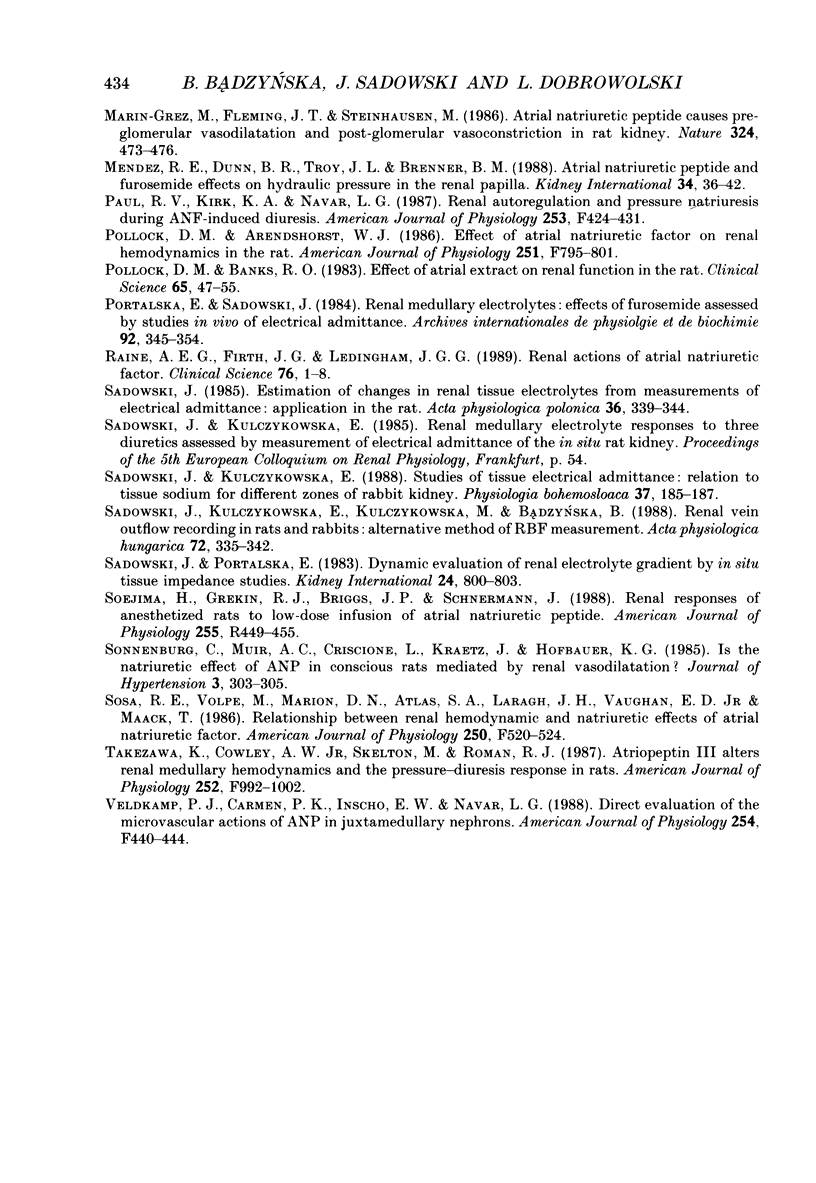
Images in this article
Selected References
These references are in PubMed. This may not be the complete list of references from this article.
- Aalkjaer C., Mulvany M. J., Nyborg N. C. Atrial natriuretic factor causes specific relaxation of rat renal arcuate arteries. Br J Pharmacol. 1985 Oct;86(2):447–453. doi: 10.1111/j.1476-5381.1985.tb08914.x. [DOI] [PMC free article] [PubMed] [Google Scholar]
- Awazu M., Granger J. P., Knox F. G. Natriuretic effect of atrial natriuretic peptide in diabetes insipidus rats. Proc Soc Exp Biol Med. 1988 Feb;187(2):165–168. doi: 10.3181/00379727-187-42650. [DOI] [PubMed] [Google Scholar]
- Banks R. O. Effects of a physiological dose of ANP on renal function in dogs. Am J Physiol. 1988 Nov;255(5 Pt 2):F907–F910. doi: 10.1152/ajprenal.1988.255.5.F907. [DOI] [PubMed] [Google Scholar]
- Burnett J. C., Jr, Opgenorth T. J., Granger J. P. The renal action of atrial natriuretic peptide during control of glomerular filtration. Kidney Int. 1986 Jul;30(1):16–19. doi: 10.1038/ki.1986.144. [DOI] [PubMed] [Google Scholar]
- Christensen S., Steiness E., Christensen H. Tubular sites of furosemide natriuresis in volume-replaced and volume-depleted conscious rats. J Pharmacol Exp Ther. 1986 Oct;239(1):211–218. [PubMed] [Google Scholar]
- Criscione L., Burdet R., Hänni H., Kamber B., Truog A., Hofbauer K. G. Systemic and regional hemodynamic effects of atriopeptin II in anesthetized rats. J Cardiovasc Pharmacol. 1987 Feb;9(2):135–141. doi: 10.1097/00005344-198702000-00002. [DOI] [PubMed] [Google Scholar]
- Davis C. L., Briggs J. P. Effect of atrial natriuretic peptides on renal medullary solute gradients. Am J Physiol. 1987 Oct;253(4 Pt 2):F679–F684. doi: 10.1152/ajprenal.1987.253.4.F679. [DOI] [PubMed] [Google Scholar]
- Davis C. L., Briggs J. P. Effect of reduction in renal artery pressure on atrial natriuretic peptide-induced natriuresis. Am J Physiol. 1987 Jan;252(1 Pt 2):F146–F153. doi: 10.1152/ajprenal.1987.252.1.F146. [DOI] [PubMed] [Google Scholar]
- Firth J. D., Raine A. E., Ledingham J. G. Low concentrations of ANP cause pressure-dependent natriuresis in the isolated kidney. Am J Physiol. 1988 Sep;255(3 Pt 2):F391–F396. doi: 10.1152/ajprenal.1988.255.3.F391. [DOI] [PubMed] [Google Scholar]
- Hansell P., Ulfendahl H. R. The influence of Atriopeptins I and II on the relationship between glomerular filtration and natriuresis. Acta Physiol Scand. 1987 Mar;129(3):361–369. doi: 10.1111/j.1748-1716.1987.tb08079.x. [DOI] [PubMed] [Google Scholar]
- Harris P. J., Skinner S. L., Zhuo J. The effects of atrial natriuretic peptide and glucagon on proximal glomerulo-tubular balance in anaesthetized rats. J Physiol. 1988 Aug;402:29–42. doi: 10.1113/jphysiol.1988.sp017192. [DOI] [PMC free article] [PubMed] [Google Scholar]
- Hildebrandt D. A., Banks R. O. Effect of atrial natriuretic factor on renal function in rats with papillary necrosis. Am J Physiol. 1987 Jun;252(6 Pt 2):F977–F980. doi: 10.1152/ajprenal.1987.252.6.F977. [DOI] [PubMed] [Google Scholar]
- Hirata Y., Ishii M., Sugimoto T., Matsuoka H., Sugimoto T., Kangawa K., Matsuo H. The effects of human atrial 28-amino acid peptide on systemic and renal hemodynamics in anesthetized rats. Circ Res. 1985 Oct;57(4):634–639. doi: 10.1161/01.res.57.4.634. [DOI] [PubMed] [Google Scholar]
- Kiberd B. A., Larson T. S., Robertson C. R., Jamison R. L. Effect of atrial natriuretic peptide on vasa recta blood flow in the rat. Am J Physiol. 1987 Jun;252(6 Pt 2):F1112–F1117. doi: 10.1152/ajprenal.1987.252.6.F1112. [DOI] [PubMed] [Google Scholar]
- Kondo Y., Imai M., Kangawa K., Matsuo H. Lack of direct action of alpha-human atrial natriuretic polypeptide on the in vitro perfused segments of Henle's loop isolated from rabbit kidney. Pflugers Arch. 1986 Mar;406(3):273–278. doi: 10.1007/BF00640913. [DOI] [PubMed] [Google Scholar]
- Lappe R. W., Smits J. F., Todt J. A., Debets J. J., Wendt R. L. Failure of atriopeptin II to cause arterial vasodilation in the conscious rat. Circ Res. 1985 Apr;56(4):606–612. doi: 10.1161/01.res.56.4.606. [DOI] [PubMed] [Google Scholar]
- Lote C. J., Snape B. M. Collecting duct dlow rate as a determinant of equilibration between urine and renal papilla in the rat in the presence of a maximal antidiuretic hormone concentration. J Physiol. 1977 Sep;270(2):533–544. doi: 10.1113/jphysiol.1977.sp011967. [DOI] [PMC free article] [PubMed] [Google Scholar]
- Marin-Grez M., Fleming J. T., Steinhausen M. Atrial natriuretic peptide causes pre-glomerular vasodilatation and post-glomerular vasoconstriction in rat kidney. Nature. 1986 Dec 4;324(6096):473–476. doi: 10.1038/324473a0. [DOI] [PubMed] [Google Scholar]
- Méndez R. E., Dunn B. R., Troy J. L., Brenner B. M. Atrial natriuretic peptide and furosemide effects on hydraulic pressure in the renal papilla. Kidney Int. 1988 Jul;34(1):36–42. doi: 10.1038/ki.1988.142. [DOI] [PubMed] [Google Scholar]
- Paul R. V., Kirk K. A., Navar L. G. Renal autoregulation and pressure natriuresis during ANF-induced diuresis. Am J Physiol. 1987 Sep;253(3 Pt 2):F424–F431. doi: 10.1152/ajprenal.1987.253.3.F424. [DOI] [PubMed] [Google Scholar]
- Pollock D. M., Arendshorst W. J. Effect of atrial natriuretic factor on renal hemodynamics in the rat. Am J Physiol. 1986 Nov;251(5 Pt 2):F795–F801. doi: 10.1152/ajprenal.1986.251.5.F795. [DOI] [PubMed] [Google Scholar]
- Pollock D. M., Banks R. O. Effect of atrial extract on renal function in the rat. Clin Sci (Lond) 1983 Jul;65(1):47–55. doi: 10.1042/cs0650047. [DOI] [PubMed] [Google Scholar]
- Portalska E., Sadowski J. Renal medullary electrolytes: effects of furosemide assessed by studies in vivo of electrical admittance. Arch Int Physiol Biochim. 1984 Dec;92(5):345–354. doi: 10.3109/13813458409080610. [DOI] [PubMed] [Google Scholar]
- Raine A. E., Firth J. G., Ledingham J. G. Renal actions of atrial natriuretic factor. Clin Sci (Lond) 1989 Jan;76(1):1–8. doi: 10.1042/cs0760001. [DOI] [PubMed] [Google Scholar]
- Sadowski J. Estimation of changes in renal tissue electrolytes from measurements of electrical admittance: application in the rat. Acta Physiol Pol. 1985 Sep-Dec;36(5-6):339–344. [PubMed] [Google Scholar]
- Sadowski J., Kulczykowska E., Kulczykowski M., Badzyńska B. Renal vein outflow recording in rats and rabbits: alternative method of R.B.F. measurement. Acta Physiol Hung. 1988;72(3-4):335–342. [PubMed] [Google Scholar]
- Sadowski J., Kulczykowska E. Studies of tissue electrical admittance: relation to tissue sodium for different zones of rabbit kidney. Physiol Bohemoslov. 1988;37(2):185–187. [PubMed] [Google Scholar]
- Sadowski J., Portalska E. Dynamic evaluation of renal electrolyte gradient by in situ tissue impedance studies. Kidney Int. 1983 Dec;24(6):800–803. doi: 10.1038/ki.1983.231. [DOI] [PubMed] [Google Scholar]
- Soejima H., Grekin R. J., Briggs J. P., Schnermann J. Renal response of anesthetized rats to low-dose infusion of atrial natriuretic peptide. Am J Physiol. 1988 Sep;255(3 Pt 2):R449–R455. doi: 10.1152/ajpregu.1988.255.3.R449. [DOI] [PubMed] [Google Scholar]
- Takezawa K., Cowley A. W., Jr, Skelton M., Roman R. J. Atriopeptin III alters renal medullary hemodynamics and the pressure-diuresis response in rats. Am J Physiol. 1987 Jun;252(6 Pt 2):F992–1002. doi: 10.1152/ajprenal.1987.252.6.F992. [DOI] [PubMed] [Google Scholar]
- Veldkamp P. J., Carmines P. K., Inscho E. W., Navar L. G. Direct evaluation of the microvascular actions of ANP in juxtamedullary nephrons. Am J Physiol. 1988 Mar;254(3 Pt 2):F440–F444. doi: 10.1152/ajprenal.1988.254.3.F440. [DOI] [PubMed] [Google Scholar]



